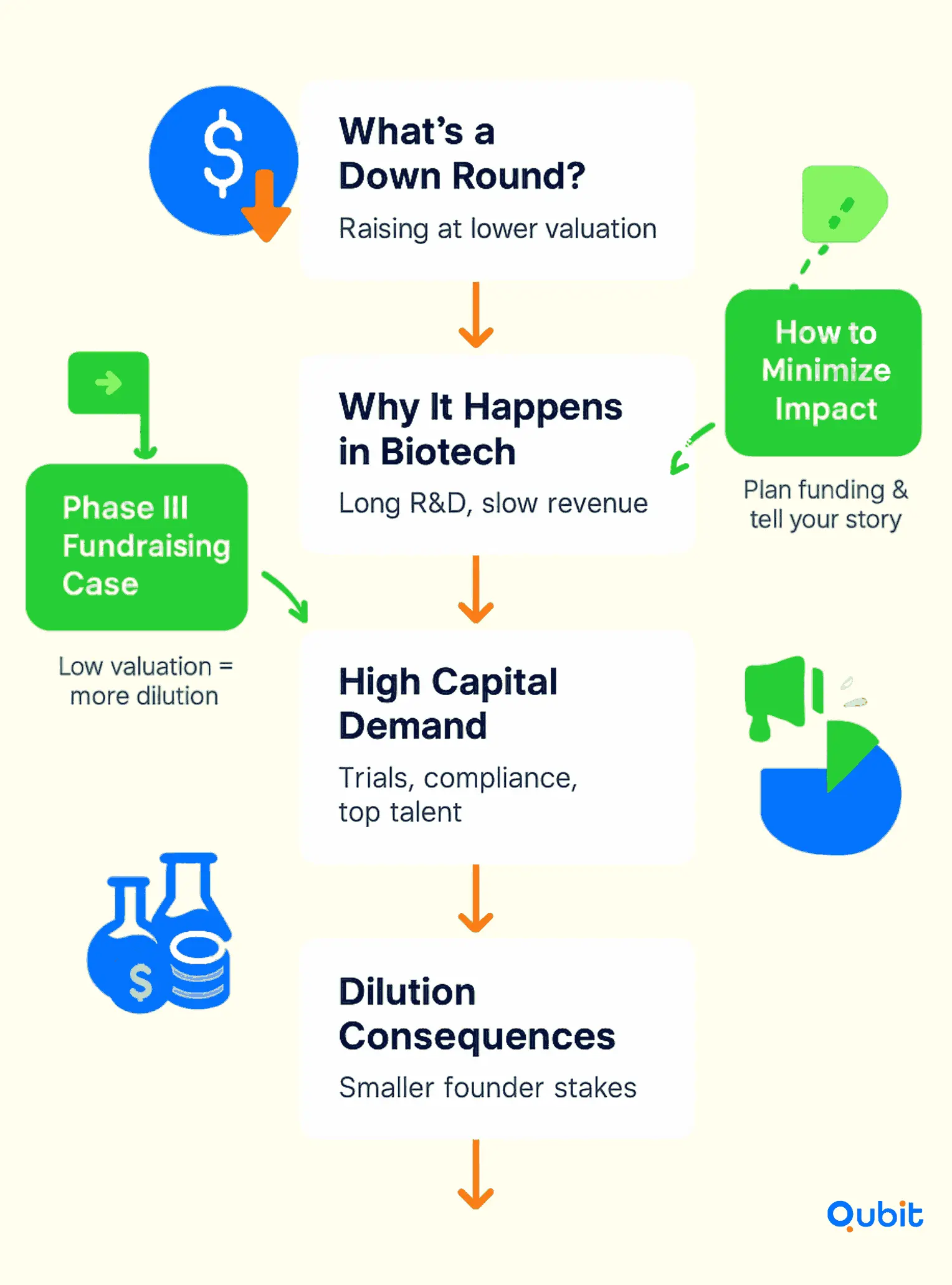Dilution is a critical concern for biotech founders and investors alike. As companies progress through funding rounds, the challenge of maintaining equity stakes while securing necessary capital becomes increasingly complex.
To set the stage, consider the role of financing strategies in biotech. Whether navigating down rounds or structuring syndicates, understanding dilution management is essential for long-term success. For a deeper dive into foundational concepts, explore biotech startup fundraising strategies, which provide valuable insights into early-stage funding approaches.
This article explores strategies to manage dilution effectively, focusing on follow-on rounds and syndicates.
Let's get started!
What is Dilution and Down Rounds?

When startups raise capital at valuations lower than previous rounds, a phenomenon known as a "down round" occurs. This situation often leads to dilution, where existing shareholders see their ownership percentage decrease as new shares are issued to attract investors. For biotech startups, these challenges are particularly pronounced due to their unique business model and funding requirements.
Biotech companies typically require substantial capital to fund lengthy research and development cycles, often spanning years before a product reaches the market. Unlike other industries, where revenue generation can begin relatively early, biotech startups face extended periods of uncertainty. This prolonged timeline increases the likelihood of encountering down rounds, especially if milestones are delayed or market conditions shift.
Dilution in biotech is further compounded by the high costs associated with clinical trials, regulatory approvals, and specialized talent. To secure the necessary funding, these startups may need to offer significant equity stakes to investors, reducing the ownership percentage of founders and early stakeholders. For example, a biotech firm raising funds to complete Phase III clinical trials might accept a lower valuation to ensure the project’s continuation, resulting in a down round and increased dilution.
Understanding these dynamics is crucial for biotech entrepreneurs aiming to balance growth with ownership retention. By strategically planning funding rounds and communicating long-term potential to investors, startups can mitigate the impact of dilution while navigating the complexities of down rounds.
Impact of Dilution and Down Rounds on Valuation and Financial Strategy
Down rounds and dilutive financing can significantly alter the financial landscape of a company, reshaping valuation metrics and investor sentiment. When a company accepts funding at a lower valuation than previous rounds, it signals potential challenges in growth or market positioning. This shift can erode investor confidence, making it harder to secure favorable terms in future fundraising efforts.
Dilution is a critical consequence of down rounds, directly impacting founder ownership and equity distribution. For instance, consider a scenario where a company with a pre-money valuation of $500,000 receives a $1,000,000 investment, resulting in a post-money valuation of $1,500,000. In this case, founder dilution reaches 33%, illustrating how quickly equity can diminish under such circumstances. This example highlights the importance of understanding dilution outcomes and their implications for long-term strategic planning.
Operational priorities often shift in response to these financial changes. Companies may need to redirect cash flow toward immediate growth initiatives or cost-cutting measures to regain investor trust and stabilize their valuation. Additionally, financial strategies must adapt to address the heightened scrutiny from stakeholders, focusing on transparency and measurable performance metrics.
For a deeper understanding of valuation benchmarks relevant to follow-on funding and down rounds, explore biotech series A valuation benchmarks 2025. This resource provides valuable insights into industry standards, helping businesses align their strategies with market expectations.
Governance, Ownership and Implications
The introduction of new investors into a company often reshapes its governance and ownership structure. Equity dilution, a common consequence of fundraising rounds, reduces the percentage of ownership held by existing shareholders, including founders. This shift can significantly impact decision-making processes and control dynamics within the organization.
Governance Shifts and Exit Options
When new investors acquire equity, they frequently seek representation on the board of directors. This can alter the balance of power, introducing fresh perspectives but also potential conflicts. Founders may find their influence diminished as investors prioritize their own interests, such as accelerating growth or preparing for an exit. Advanced exit strategies receive further nuance through biotech IPO SPAC preparation, offering insights that align with your progression towards public market considerations.
Dilution also affects exit strategies. Investors with significant stakes often push for specific outcomes, such as mergers, acquisitions, or public offerings, that align with their financial goals. Founders must carefully evaluate these options to ensure they align with the long-term vision of the company.
Control Dynamics
Equity dilution can lead to shifts in control, especially during down rounds or when large institutional investors enter the picture. Founders may lose majority control, making it challenging to steer the company in their desired direction. This underscores the importance of negotiating terms that protect founder interests, such as maintaining voting rights or implementing protective provisions.
Understanding the implications of dilution is crucial for founders aiming to preserve their vision while accommodating investor demands. Balancing governance, ownership, and exit strategies requires strategic foresight and careful planning.
Financing Strategies and Management Approaches
Biotech startups often face unique challenges when securing funding, especially when trying to preserve equity. Exploring diverse financing strategies can help founders mitigate dilution while ensuring operational growth.
1. Equipment Leasing: Access Without Equity Dilution
For startups requiring high-cost laboratory instruments, equipment leasing offers a practical solution. Instead of issuing new shares to raise capital, companies can lease essential equipment, reducing upfront expenditures and preserving equity. This approach allows startups to allocate their resources more effectively while maintaining control over their ownership structure. Highlighting the use of equipment leasing can demonstrate how biotech firms reduce financial strain during critical growth phases.
2. Venture Debt: Supplemental Capital for Operational Costs
Venture debt provides a short-term financing option that complements equity rounds without immediate dilution. This strategy is particularly useful for bridging operational costs between funding cycles, ensuring continuity in research and development. By utilizing venture debt, startups can maintain momentum without compromising ownership stakes. For a deeper understanding of non-equity financing, explore biotech venture debt royalty financing, which outlines alternative funding structures tailored to biotech needs.
3. Strategic Partnerships: Collaborative Growth Opportunities
Strategic partnerships with established industry players can offer both financial support and access to resources, such as expertise or infrastructure. These collaborations often come with non-dilutive funding arrangements, allowing startups to scale operations while retaining equity. As late-stage biotech funding becomes increasingly cautious, founders are proactively seeking such partnerships earlier in their journey to avoid more dilutive financing options later.
Rebuilding Confidence and Real-Life Examples
Recovering from dilution requires a blend of strategic resets and transparent communication to rebuild investor trust. Companies that successfully navigate this phase often emerge stronger, with renewed confidence from stakeholders. One standout example is Zoom’s pre-IPO journey, which offers valuable lessons for biotech founders.
Strategic Resets to Reassure Investors
Transparent Communication
Investors value honesty, especially during challenging times. Clearly outlining the reasons behind dilution and presenting a roadmap for recovery can help restore confidence. Regular updates on milestones achieved post-dilution demonstrate commitment and progress.Re-evaluating Equity Allocations
Strategic adjustments to equity distribution can mitigate the impact of dilution. For instance, offering performance-based equity incentives to key stakeholders ensures alignment with long-term goals.Prioritizing Sustainable Growth
Focusing on sustainable growth strategies post-dilution is critical. This approach not only reassures investors but also sets the stage for future funding rounds. For insights on maintaining momentum after initial fundraising, explore strategies for scaling biotech startup funding.
Lessons from Zoom’s Pre-IPO Journey
Zoom’s story is a testament to the power of strategic planning. Before its IPO, the company raised over $145 million, resulting in significant dilution. Despite this, the founder’s stake retained substantial value, thanks to careful management of follow-on rounds. By maintaining transparency and focusing on growth, Zoom successfully navigated dilution while preserving investor confidence.
Biotech founders can draw inspiration from Zoom’s approach to equity management and stakeholder communication. These strategies highlight the importance of balancing immediate funding needs with long-term equity value.
Rebuilding confidence after dilution is challenging but achievable. By implementing strategic resets and learning from real-world examples like Zoom, companies can reassure investors and pave the way for sustainable growth.
Conclusion
Strategic financing is the cornerstone of successful biotech ventures, especially when managing dilution. By implementing thoughtful strategies, such as exploring alternative funding sources and maintaining robust governance practices, companies can safeguard their valuation while fostering sustainable growth. The discussions on valuation shifts and governance changes underscore the importance of aligning financial decisions with long-term objectives.
As you consider your funding approach, remember that the right capital structure can make all the difference. At Qubit Capital, we specialize in Fundraising Assistance to help you secure optimal funding while minimizing dilution.
If you're ready to take the next step, contact us today to start your journey toward financial success.
Key Takeaways
• Biotech startups face unique dilution challenges due to high capital needs and long development cycles.
• Down rounds can significantly impact valuation, cash flow, and founder ownership.
• Effective governance and strategic exit planning are crucial post-dilution.
• Diverse financing strategies, including non-dilutive options, can help mitigate dilution.
• Real-life examples, such as Zoom’s journey, offer valuable insights for managing dilution.
Frequently asked Questions
What is dilution in biotech funding rounds?
Dilution in biotech funding rounds occurs when existing shareholders experience a decrease in their ownership percentage. This typically happens when new capital is raised at lower valuations, often during down rounds.


 Back
Back



